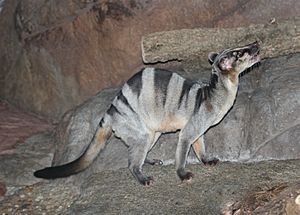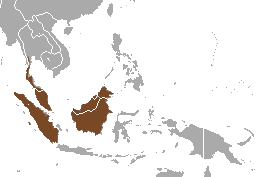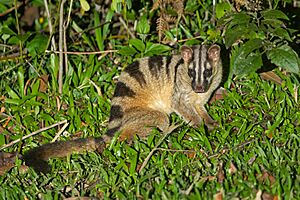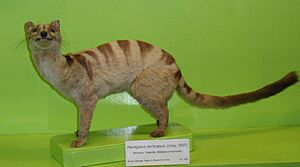Banded palm civet facts for kids
Quick facts for kids Banded palm civet |
|
|---|---|
 |
|
| A banded palm civet in the Cincinnati Zoo | |
| Conservation status | |
| Scientific classification | |
| Genus: |
Hemigalus
|
| Species: |
derbyanus
|
| Subspecies | |
|
|
 |
|
| Banded palm civet range | |
| Synonyms | |
|
Paradoxurus derbyanus |
|
The banded palm civet (Hemigalus derbyanus), also called the banded civet, is a wild animal that looks a bit like a cat. It lives in parts of Asia, especially in places like Indomalaya. These animals mostly live in lowland forests, which are sadly shrinking because of human activities. Experts believe that the number of banded palm civets has gone down by about 30% in recent years.
Banded palm civets are usually about the size of a regular house cat. They have pale fur with cool dark bands on their backs. They are thought to be related to Hose's palm civets, which look similar and live in the same areas. The banded palm civet is the only species in its group, and scientists first described it in 1837. There are four different types, or subspecies, of banded palm civets found across Indonesia and Southeast Asia. Some of these subspecies separated from each other a very long time ago, about 2.7 million years!
These civets can get parasites, like tiny worms called nematodes. They mostly eat meat, hunting small animals like rodents and bugs. They have special sensitive hairs on their paws that help them find their prey.
Contents
About the Banded Palm Civet
What's in a Name?
The scientific name for the banded palm civet's group, Hemigalus, was first given in 1837 by a scientist named Claude Jourdan. He had a skin and a skeleton of one of these animals to study. The name Hemigalus comes from two Greek words: hemi meaning "half" and galus meaning "weasel." This name was chosen because of how the animal looks.
Another scientist, John Edward Gray, also described a specimen from the Malay Peninsula in the same year. Later, in 1939, Reginald Innes Pocock grouped all these similar civets under the Hemigalus name.
Different Types of Banded Palm Civets
There are four known subspecies of the banded palm civet:
- H. derbyanus derbyanus: Found in Myanmar, mainland Malaysia, and Sumatra.
- H. d. boiei: Found only on the island of Borneo.
- H. d. minor: Found on South Pagai and the Mentawai islands.
- H. d. sipora: Found on Sipora and the Mentawai islands.
There's also a group of these civets on Siberut island, but scientists haven't yet decided which subspecies they belong to. Scientists believe that the H. d. minor and H. d. derbyanus subspecies started to become different from each other about 2.7 million years ago.
What They Look Like
The banded palm civet usually has pale fur, which can be light brown, gray, whitish, or yellowish. They have seven to eight dark bands on their face and across their back. These bands are usually dark brown, black, or a reddish-brown color.
These civets are about the size of a domestic cat. They can grow up to 53 cm (21 in) long, not counting their tail, and weigh between 1–3 kg (2.2–6.6 lb). Their tail is usually about three-quarters the length of their body and head combined. Interestingly, their tail can swell up if they feel threatened, making them look bigger. They also have very sensitive hairs between the pads of their paws, which helps them feel around and find food.
Where They Live
Banded palm civets are found in several countries, including Myanmar, Thailand, Peninsular Malaysia, Sumatra, the Mentawai Islands, and Borneo. They can live from sea level up to high elevations of 1,660 m (5,450 ft).
In Myanmar, they were rarely seen for a long time, but in 2022, a camera trap photographed one for the first time in a reserved forest. In Thailand, camera traps have also captured photos of them in different evergreen forests. They've also been recorded in hilly forests in Peninsular Malaysia and in primary forests in Sumatra. Sadly, they disappeared from Singapore in the early 1900s.
How They Live
Banded palm civets are nocturnal animals, meaning they are active at night. During the day, they usually rest in holes in low trees. They are thought to be solitary, meaning they prefer to live alone. When they sense danger, they can make their tails swell up to look more intimidating.
What They Eat
The banded palm civet is a carnivore, which means it mostly eats meat. They hunt a variety of small animals like crabs, ants, spiders, worms, rats, frogs, small reptiles, and birds. Sometimes, they might also eat a bit of plants or fruits.
They often hunt near water or on the forest floor. To catch larger prey, they bite the back of the animal's neck and shake it. They then hold the prey with their front paws to attack with their teeth.
Family Life
Female banded palm civets usually have one or two litters of young each year, with one or two babies in each litter. The babies are born after a gestation period of about 32 to 64 days.
In the wild, these civets typically live for about twelve years. However, one civet that was kept in captivity lived for eighteen years! Newborn civets are very small, weighing only about 125 g (4.4 oz). They usually open their eyes about eight to twelve days after they are born and drink their mother's milk for up to 70 days.
Dangers They Face
The biggest threat to banded palm civets is the loss of their natural home. Forests are being cut down for logging, farms, plantations (like palm oil), and building dams. They are also hunted and eaten by local people in some areas. Their favorite home, the lowland forest, is especially at risk.
In 2016, it was thought that the number of banded palm civets had dropped by 30% in just three generations. By 2022, estimates suggested their population had shrunk to only about 21% of what it used to be. Some people also take them from the wild to keep as pets, which is harmful to their populations.
Protecting Them
The banded palm civet is listed as Near Threatened on the IUCN Red List, which means their population is decreasing and they could become endangered if things don't change. They are also protected under CITES' Appendix II, which helps control their trade.
About 24% of the areas where they live are in protected areas, like national parks, but a study in 2022 suggested this number might be closer to 12%. Protecting these areas is very important for the future of the banded palm civet.
Images for kids





